Please Take Note: This is a review of the final game, but it might change slightly based on the success of the Kickstarter campaign. The game is being reviewed on the components and the rules provided with the understanding that “what you see is not what you might get” when the game is published. If you like what you read and want to learn more, we encourage you to visit the game’s web page or visit the Kickstarter campaign. Now that we have all that disclaimer junk out of the way, on with the review!
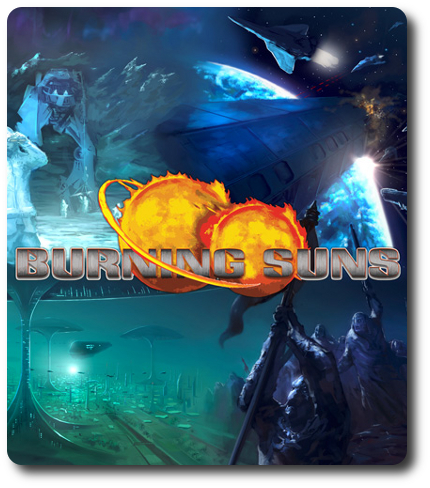
The Basics:
- For ages 14 and up
- For 2 to 5 players
- Approximately 40 minutes per player.
Geek Skills:
- Active Listening & Communication
- Counting & Math
- Logical & Critical Decision Making
- Reading
- Pattern/Color Matching
- Strategy & Tactics
- Risk vs. Reward
- Cooperative & Team Play
- Hand/Resource Management
- Auctioning, Bidding, & Trading
- Worker Placement & Area Control
Learning Curve:
- Child – Hard
- Adult – Moderate
Theme & Narrative:
- Guide your empire to become the ruling super power in the galaxy.
Endorsements:
- Gamer Geek approved!
- Parent Geek rejected!
- Child Geek not applicable!
Overview
Peace and prosperity has flourished from one end of the galaxy to the other, but even in this time of plenty, there are those who hunger for more. It began with a simple skirmish, and from there, dissent and fear spread. Friends are now enemies and unlikely alliances have become common place. Some empires seek solace by searching for ancient relics to guide them. For others, only the drums of war bring comfort. How will you lead your empire through these troubled times?
Burning Suns, designed by Emil Larsen and to be published by SunTzuGames, will reportedly be comprised of a lot. In fact, it’s difficult to really determine what will be included in the box at the time of this review as the basic game components are upgraded and added to based on overfunding goals being met. As this is a review of a prepublished game, we will not comment on the game component quality. The provided example illustrations and the private conversations we’ve had in regards to “what’s coming” all point to Burning Suns being a very component heavy game with a real eye for detail.
Game Set Up
Game set up is best done in phases. This is because the majority of game set up is important to later game play. As such, the game set up process is fairly involved and does require all the players to participate. In other words, just sitting people down to play the game after it’s set up without their input puts them at a disadvantage. Each of the game set up phases are summarized here.
Note that you will need a lot of table space to play Burning Suns. Even if you only play with 2 players, expect to take up a table that comfortably sits 5 people.
Yep…big game.
Phase 1: Build the Galaxy
The first thing each player must do is select a homeworld and then build the galaxy they will be playing in. Homeworlds are placed face-up and are visible to all the players at the table. The other parts of the galaxy include inhabited, hostile, and uninhabited systems, as well as very small systems that dot the galactic landscape. These remain face-down and unknown until such time a player explores them.
There are several ways the players can build the galaxy. The rule book will include pre-built galaxy designs for 2 to 5 players. This is the fastest way to complete this portion of the game set up. There are also rules included that describe how players can create their own galaxies. Regardless of what is used, pre-built or customized galaxies, each game will have a galaxy that is randomly populated.
While building the galaxy isn’t difficult, it can be rather time-consuming if building the larger ones for games with many players. Patterns must be perfectly matched and the placement of each of the systems is very important. Burning Suns is not played on a game board, but a galaxy of specifically placed systems that define not only the game playing area, but the overall necessary space to play it in.
Here are a few examples of the many ways you can set up the galaxy depending on the number of players in the game.
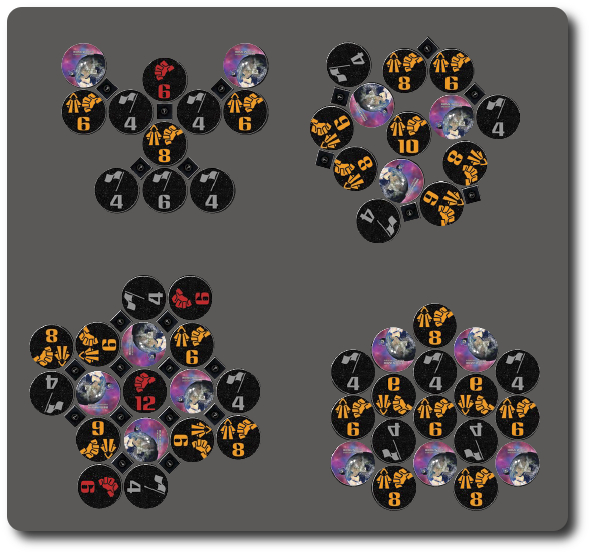
Phase 2: Choose Empires
Each player will take on the role of Supreme Overlord for a specific alien empire. At the very least, Burning Suns will include Terrans (humans), Templars, and Cyborgs. More races might be included based on overfunding goals. Empires are comprised of 3 sheets. The first defines the race itself, the second is the race’s ideology, and the third is the race’s structure. Since all three parts that make up the empire can be randomized or specifically selected by the player, there is a great deal of customization and uniqueness that can occur each game.
- The ideology of the empire more or less defines its power base and what it relies on. Each Ideology sheet has 4 levels of abilities (levels 0 to 3) and each empire starts with the “0” ability unlocked. As the game progresses, Antimatter the empire gains unlocks new abilities. Players will have to pick between abilities, as the ideology of a specific empire can branch. Abilities get stronger each level, but an empire can lose access to the abilities if their Antimatter is reduced to a level that no longer allows it.
- The race of an empire identifies it Leaders, their default attack ability, ships, upgrade slots, technology slots, and unique units.
- The structure of the empire defines the basic actions and abilities available in the game, but every Structure sheet provides a small benefit to these actions and abilities. For example, one might be more focused on combat while another might be more focused on trade. While useful to a player when determining what actions or abilities they should take, no one structure available in the game has a clear advantage over the other.
The end result will be a unique alien empire, with a unique name, every game. Once selected, the Ideology, Race, and Structure sheets are placed in front of the player, face-up.
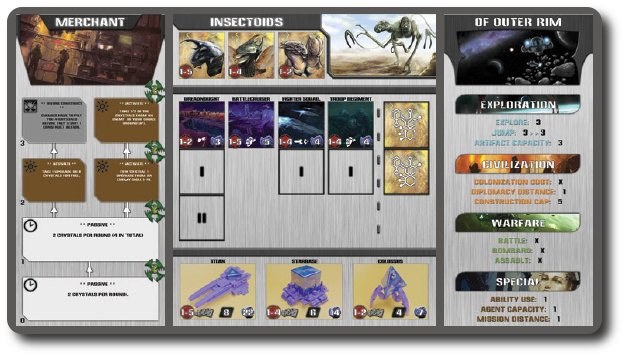
Then each player will collect their three Race Leaders (specific to each race), and 6 Race cards. The Race cards define the a race’s focus. Specifically, war, trade, or peaceful exploration.
Phase 3: Collect and Organize Player Components
Each player will now select 1 of 5 possible color choices that will represent their empire for the duration of the game. Each color is also a different symbol which should make it easy for those players who have difficulty distinguishing colors. Once the player selects their color, they will collect 6 Dreadnoughts, 6 Battlecruisers, 6 Fighter Squadrons, and 13 Troop Regiment/Control Markers. From this collected mass, the player will place 1 Dreadnought, 1 Battlecruiser, 1 Fighter Squadron, and 1 Troop Regiment on their homeworld. This represents the race’s starting strength and the rest of the components collected so far represent future improvements.
In addition, the player will collect 1 Titan, 1 Starbase, and 1 Colossus. These each use specific die to represent their current strengths and weaknesses. Specifically, an eight-sided, a six-sided, and a four-sided die. All the dice should be the same color and be selected by the player at this time.
When completed, a player’s game area might look something like the following. Be sure that each player leaves room for future Artifacts, Agents, and collected Crystals (shown in the image).
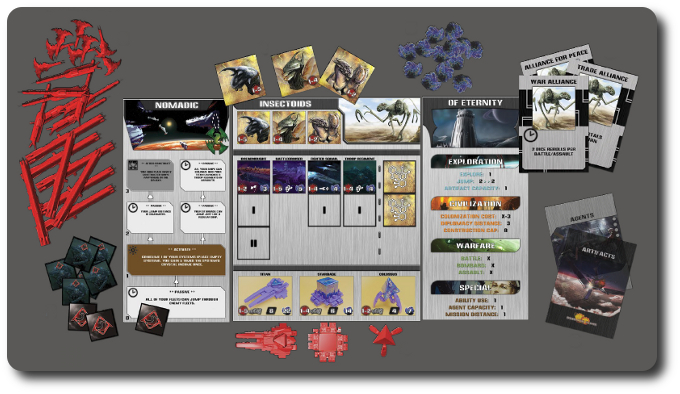
Phase 4: Collect and Organize Game Components
Now that each player has their own specific game area set up, it’s time to focus on the galaxy!
Place the 4 Action sheets to one side of the game playing area and set them so they are side-by-side and face-up. These cards will be shuffled during the game, so keep them close by at least one player.
The Agent cards represent specific and unique individuals that the player can use to obtain special actions and abilities. The Agent deck is shuffled, placed face-down, and either 1 or 2 Agent cards are drawn and placed face-up side-by-side. The number of cards drawn is dependent on the number of players.
The Artifact cards represent advanced and mysterious technology or relics that can be found in the vastness of space. The Artifact deck is shuffled, placed face-down, and either 1 or 2 Artifact cards are drawn and placed face-up side-by-side. The number of cards drawn is dependent on the number of players.
The galaxy has a thriving economy which is represented by the Galactic Market card. The Galactic Market card is placed to one side of the game playing area and the Items that can be purchased are placed in a bag, shuffled, and then drawn at random. The number of items available from the market is based on the number of players in the game.
Finally, the Militia and Dark Ships should be placed in a pile off to one side (they’ll be used later in the game when players stumble into hostile systems), the Antimatter track should be placed to the side with each player setting 1 Control Marker on the starting spot (zero), and the Crystals should be placed in a pile with chips and the combat dice, as well.
Is that it? Jeepers, we hope so. Let’s get to the game!
Intergalactic Game Play
Note: We are only going to scratch the surface of how to play Burning Suns. This is a big game that gives the players a lot to think about. We will only cover the basics of a typical game round here and HIGHLY encourage you to read the game rules for all the details.
Burning Suns is played in rounds. Each round is separated into phases with players taking actions in turn order sequence. A typical round is defined here in generic terms. Individual player choices and actions will change each round based on what the player wants to accomplish and what is available.
Phase 1: Collect Income
Income in the game is represented by Crystals which act as a resource to buy and trade with. Players obtain Crystals by colonizing planets and systems, as well as building improvements and placing them in areas they control. This part of the phase can be done one player at a time (which we recommend) or every player can simply determine how many Crystals they collect and grab them from the Crystal pile off to the side of the game playing area.
Phase 2: Refill
During the previous round, the Galactic Market might have been picked over. No worries. The galaxy is all about production and new Items are added to the marketplace if there is an open slot, but only if the slot is blue or green in color. At this time, any face-up Agent and Artifact cards are also exchanged with older cards going to the bottom of their respective decks and new cards being drawn.
Phase 3: Shuffle and Place Action Sheets
The players will always be using the same Action sheets, but the turn order in which the actions take place is randomized every round. The Action sheets are taken, shuffled, and then placed side-by-side. Starting with the furthest card on the left and the first action at the top, the action order will progress downwards. Once the last action on the Action sheet is taken, the top most action on the next Action sheet at right is taken.
Phase 4: Assign Leaders
Now the fun and difficulty really beings. Starting with the first player, and continuing in turn order sequence, each player will place their Leaders to any empty slots on the Action sheets. The first player who passes instead of placing a Leader will become the first player in the next round. If no player passes, the player who takes the last action this round will become the first player next round.
Phase 5: Execute Actions
Starting with the top most left action, players will now take the actions indicated on the Action sheet whenever their Leader is on the action being focused on. If an action doesn’t have a Leader, it’s simply skipped.
When the player’s Leader is being focused on, they can complete the action or decide not to take the action. Regardless, the player’s Leader is removed and returned to their empire. There might also be times when the player cannot complete the action they intended, in which case, the Leader returns to the empire, too.
Note that all actions, benefits, and abilities are automatically activated and take place as soon as they are purchased or collected.
This concludes a single round in the game. If the victory condition has not yet been met, a new round now begins starting with phase 1 as described above.
A Quick Scan of the Actions
As the game progresses, the players will adjust the actions they want to take, use unlocked empire abilities, equip new items, and change their focus. Here is a brief summary of some of the actions available in the game.
Warfare Actions
As the name suggests, these actions allow the player to battle opponents and hostile elements in the game. Antimatter is won through victories, which makes combat in the game not only frequent, but essential to victory and an empire’s strength. The warfare actions include:
- Start a Battle
- Start a Bombardment
- Start an Assault
Exploration Actions
Throughout the endless tracks of space, players will find allies, resources, and relics that will make their empire stronger, including finding means to produce Antimatter, as well as new systems that can be colonized. The exploration actions include:
- Explore a System or Galactic Market
- Move Fleets or Ground Forces to Systems
- Scan to Find Artifacts and Crystals
Civilization Actions
As the empire grows, so too does its need to expand. These actions focus on moving beyond the player’s homeworld and improving the empire’s civilization as a whole. The civilization actions include:
- Colonize a System
- Persuade a System to Change Alliances
- Build Units and Items
Special Actions
The Special actions allow the player to use abilities that only they can access, perform critical missions, and recruit friends. The special actions include:
- Use Ability
- Recruit Agent
- Conduct Mission
Read the game rules for a full description of each ability listed above.
Victory Over All
The game continues until a player has accumulated the required amount of Antimatter to win. If playing cooperatively or using diplomatic victory conditions, the necessary amount of Antimatter will be different than the total amount required by one player.
That’s all we are going to cover here. We didn’t discuss battles, construction, the economy, or colonization. There’s just too much in this game to document it all, but we should have provided a summary with enough details to help you determine if you want to learn more about the game. If you do want to learn more about Burning Suns and read the game rules, visit the game’s web page or visit the Kickstarter campaign.
Prediction
Before we get to the prediction, a quick bit of history and explanation. Burning Suns is a “4x game”. The term was reportedly first coined by Alan Emrich in 1993 in a preview for the upcoming computer game titled, Master of Orion. In the computer game, players were able to explore, expand, exploit, and exterminate. This came to be referred to as “4x” and the type of games that have these four areas of focus have been grouped together ever since, regardless if they are played on the computer, console, or large foldout tables. These games also tend to be very long and complex due to the many different ways a player can interact with the game. They also tend to be only played by Gamer Geeks.
Overall, I don’t think Burning Suns is a difficult game to learn, but I’m coming at it from the perspective of a Gamer Geek who has played lots of games, including 4x games. Each time you play a game, you learn its rules and game play. The next game you learn will most likely share some of the rules and game play you are already familiar with. In this way, the more games you play, the easier it becomes to learn new and more complex games. Burning Suns will be easy to learn for any player who is already familiar with Twilight Imperium, Eclipse, or Space Empires 4x. If a player has never played a 4x game before, the learning curve is going to a difficult one, but a player will quickly realize that each round is well structured. Like Eurogames, the real difficulty in 4x games is making short-term decisions in hopes of obtaining long-term gains.
As such, I don’t think we are going to see much love from the Child Geeks. Despite the game play being very straight forward, there is just too much to consider for a younger or inexperienced player. I’ll be lucky if I can finish a game with a Child Geek, let alone be able to finish explaining how the game is played. For the Parent Geeks, it’s going to be one way or the other. We have a few Parent Geeks who enjoy more complex and involved games from time to time to help break up the monotony of the many casual games they play. Even so, the difficulty to learn the game for adults is going to be moderate. Not many of our Parent Geeks have experience with 4x games, let alone a game the size of Burning Suns. But they do have experience playing complex Eurogames, so there might be a few Parent Geeks who really enjoy the 4x game play.
Without a doubt, the Gamer Geeks are going to enjoy Burning Suns. It feels very much like a “gamer’s game”.
Teaching Burning Suns can be a rather lengthy process or a very easy one. It all depends on your audience. When I taught it to Gamer Geeks, it took me all of 10 minutes. To Parent Geeks, about 20, and for the Child Geeks…well…let’s just say I taught it in waves and with many, many examples. You’ll want to put a great deal of emphasis on how an individual player decides what they want to do when it’s their turn. Victory is only obtained through Antimatter and the fastest way to get Antimatter is through battles. But a player will only be able to do well in battles if they explore and grow their empire which will give them the means to create very large spaceships. There are a number of paths to victory provided in Burning Suns. Some are very visible and others the player must create for themselves. Do expect the first game with inexperienced players to take a very long time and lots of pauses to explain the rules. And, again, make sure you have the players at the table when you are setting it up. Understanding the elements of a player’s empire will greatly assist them during the game.
When I put Burning Suns in front of my oldest little geek, his eyes bulged. He has played a number of complicated games in the past, including a couple of rounds of Eclipse, but he felt slightly overwhelmed just looking at all the pieces. This was especially true while we were setting up the game. After the game was set up, I asked him his thoughts on Burning Suns so far.
“I don’t even know where to start, Dad.” ~ Liam (age 9)
He isn’t alone and his statement is valid for all but the most experienced of players. I believe my little geek will quickly find that 4x games are more about the journey rather than individual actions taken. Let’s see if our journey is an epic win or an epic fail.
Final Word
As predicted, Burning Suns was too much for our Child Geeks to handle. Way too much. The oldest of the Child Geeks made it through no more than 3 rounds before they wanted to call it quits. Clearly, Burning Suns is not a game for the Child Geeks, but only because of its complexity and game length (despite being one of the shorter 4x games I have played). As such, the game was rejected by the Child Geeks, but because we couldn’t find any Child Geeks close enough to the suggested age range (14 or older), the Child Geek endorsement becomes “not applicable”.
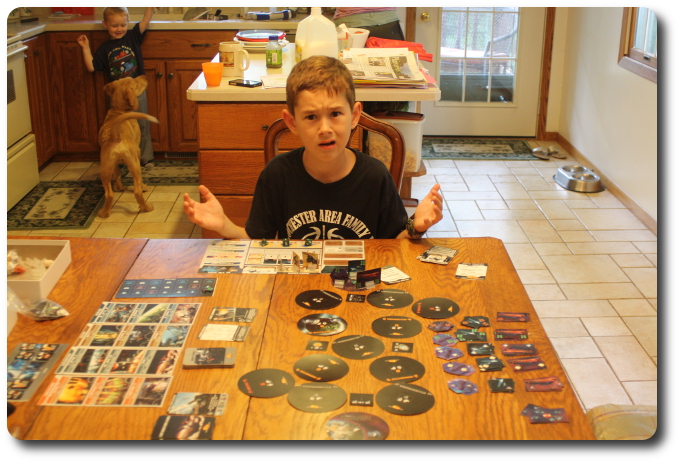
The look on my little geek’s face says it all…
The Parent Geeks were mixed at first, but as the game progressed, those Parent Geeks who were on the fence started to feel rather strongly about the game. The vast majority of the Parent Geeks voted to reject Burning Suns. According to one Parent Geek, “This is a good game, but it’s just too big for me. I can’t see myself ever wanting to play a game this size or this complex.” But that was not a point-of-view shared by all the Parent Geeks. One of the more involved Parent Geeks who plays complex and time-consuming Eurogames had this to say about Burning Suns: “Wow…OK, first off, I really like how the game plays out. I like how the action orders are different each round and the combat is pretty straight forward. The biggest problem I will have with this game is finding other players to play it with me. This is big game that I could never bring out except when I have the Gamer Geeks over. Other than that, I love it.” Due to the majority of Parent Geeks not wanting to invest so much time and energy into one game when they could play more than one game in the same amount of time it takes to play Burning Suns, they voted to reject it.
The Gamer Geeks all enjoyed the game and thought it was an excellent example of how a newer game builds off the older games that came before it. According to one Gamer Geek, “This game highly benefits from the designs of the other 4x games on the market today. I like many of the game elements and don’t care for others. Overall, an excellent addition to the 4x game family.” A few of the game rules and some of the more generic ships and items didn’t please some of the Gamer Geeks who wanted to see more race specific uniqueness throughout, but there were a number of other Gamer Geeks who rather liked the idea that everything was the same. According to the one of those Gamer Geeks, “I’ve always enjoyed games that give all the players the same building blocks and it’s up to them and their creativity to build something unique with them.” In the end, all the Gamer Geeks voted to approve Burning Suns.
Is Burning Suns for you? If you already have a favorite 4x game, perhaps not. Burning Suns is slightly shorter in game length than many of the 4x games available today, but it doesn’t bring anything new to the 4x game world. There are a number of interesting new ways to play the game, however, that are worth noting. Specifically, the way empires are built, abilities are unlocked, and the random action orders. Burning Suns can be a very aggressive game and the emphasis on earning Antimatter through battles only serves to push players into hostile environments and pick on their neighbors. For those players who would rather peacefully explore space and its mysteries, Burning Suns might feel a bit too combative. For any player who wanted more emphasis on the “extermination” portion of 4x games, Burning Suns is sure to please.
Overall, I rather enjoyed my time with Burning Suns. The rules still need some tweaking and some further explanation of a few elements of game play would go a long way to help remove any questions some of our players had. The game is not a difficult one to play once you learn it, but the learning curve can be very steep for new players. This will keep Burning Suns off my family gaming table for a long time, but until then, I will have fun racing across the galaxy with my Gamer Geek friends as we blow the holy hell out of each others ships.
This is a paid for review of the game’s final prototype. Although our time and focus was financially compensated, our words are our own. We’d need at least 10 million dollars before we started saying what other people wanted. Such is the statuesque and legendary integrity of Father Geek which cannot be bought except by those who own their own private islands and small countries.




Haha, your kid makes fantastic expressions! They always make me laugh.
This game looks great, I was highly tempted to kickstart it, but I’m going to wait for it’s release. I’ve really wanted a 4x game, and I tend more towards tactical combat than economic growth, so I think this may be my game. Gotta choose between it and Empire of the Void, I love that both of them can be played in under 2 hours.
The picture shown was the one I selected out of a group. The pictures I rejected captured my little geek looking outside with disinterest and boredom or intensely at me with eyes that spoke of burning hate.
Keep in mind that any 4x game that says it can be played in less than 2 hours is measuring the time it takes a reasonably sized groups of experienced players to complete 1 game. The total time is probably then rounded down to the nearest hour. Do not dump the contents of the box on your table and think you’ll be leaving in 2 hours. It might take you 20 minutes just to set up the game.